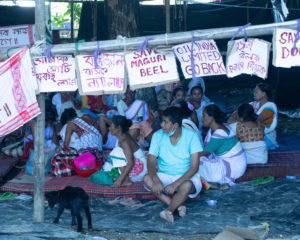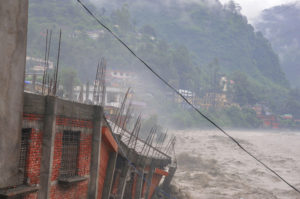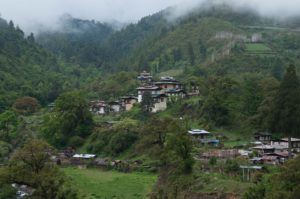Sitting 300 metres from the burning gas well, Oitendra Das’s house has been shaking from constant loud vibrations since May. Because of the dhap dhap sound, dust from the roof keeps falling on his head. He’s afraid that it will collapse one of these days.
Like other fishers in the area, Das has stopped fishing in the Dibru river since Oil India Limited’s gas well 5 blew out in a maintenance mishap on May 27. But months later, he and his family are still drinking water from the hand pump, which draws from the same river.
“Though we boil the water before drinking, we can still tell there’s something different about it. If you add sugar, it becomes oily,” Das told The Third Pole.
See: Gas well blows out in Assam
Although they initially relocated to the nearby village of Guijan, the birth of his youngest child on July 15 forced the family to return home given the looming fear of Covid-19. Moving to the relief camp made hardly any difference, he said, since it was a short walk away from their house.
Das’s family is among the 1,610 in Baghjan village affected by the blast. While over 3,000 residents are currently lodged in relief camps, many have moved back to live in their homes, situated less than a kilometre from the gas well. The blast has also caused significant damage to wildlife at nearby wetlands and national park – part of an important biodiversity hotspot in the foothills of the eastern Himalayas.

Fire still ablaze
On June 9, the well that had been discharging 90,000 standard cubic metres of gas per day at high pressure caught fire, even as a crisis-management team of OIL and Oil and Natural Gas Corporation tried to prevent the blowout.
See: Blown-out gas well in Assam bursts into flames
Government-run OIL operates 11 wells in the village, of which two are gas wells and others produce oil. The village falls within the Baghjan field, where the wells have been in operation since December 2005.
See: Drilling continues despite burning gas well in Assam
On September 13, OIL reported that the fire in the well had been tamed after 110 days of sustained operation. So far three OIL employees have died in the process and three of the six foreign experts brought in for disaster control sustained injuries.
OIL spokesperson Tridiv Hazarika told The Third Pole that a portion of the gas has been diverted to another well, where the fire is now burning at reduced pressure. He estimates it will take another three or four weeks to shut down or “kill” the well.
However, the diversion has made little difference to the sound level, said Dilip Mallah, another resident.
Long-term health impacts
On August 6, India’s National Green Tribunal accepted the preliminary report submitted by a committee it set up to look into the disaster. The report mentions complaints of breathing difficulties and sound-induced headaches by residents. It also “conjectured” that the situation was not “desirable” for the health conditions of vulnerable populations, namely, the elderly, pregnant women and children who reside nearby.
In September, The Third Pole visited Baghjan, where residents complained of constant migraine-like headaches due to the vibrations and loud noise of the fire in the well. The residents, including pregnant women, said they had accompanying mental health issues like chronic anxiety and palpitations.
On July 18, a fish farmer allegedly committed suicide over the “mental harassment” caused by the accident and the delay in compensation. He and his family had been displaced by the accident and had been living in one of the relief camps.
While OIL has paid INR 2.5 million (about USD 34,000) each to 12 families whose houses were completely destroyed, the others were given INR 30,000 (USD 400) as compensation. Demanding a compensation of INR 1 million (USD 13,600) per family, residents have been protesting in front of the district commissioner’s office in Tinsukia, with support from the local unit of the All Assam Students Union.
Apart from compensation, the NGT committee also recommended an immediate health insurance policy (including for Covid-19) to all affected individuals.
Hemanta Moran, a local teacher who has been leading the protests, said that in a meeting with OIL and the district commissioner, they had asked for the 1,600 families to be relocated to Doomdooma until the operation at the gas well was complete.
OIL contests extent of damage
Before the gas well caught fire on June 9, an Assam Pollution Control Board official told The Indian Express newspaper that a “mix of propane, methane, propylene and other gases” was being blown by winds up to five kilometres. The oil condensate from the blowout spilled into the nearby Dangori (also called Dibru) river and the Maguri-Motapung wetland, killing an endangered Gangetic river dolphin and a variety of wildlife the region is home to.
See: A cartoonist captures the biodiversity of Assam
The NGT committee report estimated the radius of the oil spill was within two kilometres but said that the effects of the gases could be felt at a distance of more than nine kilometres.
However, Hazarika of OIL told The Third Pole that the impact radius was limited to 1.5 kilometres from the gas well. He claimed the relief camps where the families have been housed fell outside of it.
When The Third Pole visited Baghjan, we found that the camps, located in the midst of other houses in the village and with no measures taken for safe distancing for Covid-19, stood less than a kilometre from the burning gas well.
Experts calculate environmental damage
The raging flame in the gas well spread like wildfire, charring trees, small tea gardens, a few houses and several courtyards. The NGT committee report said that the impact of the fire on the grasslands has led to a loss of bird density and diversity. The committee is led by former Gauhati High Court Justice B.P. Katakey, who was previously looking into the environmental impact of illegal “rat hole” coal mining in Meghalaya.
Katakey was unable to visit the site. He relied upon the findings of Wildlife Institute of India (WII) and a team of independent experts who visited the site following the blowout.
Hazarika said that while institutional experts like WII could be relied upon, OIL India had questioned the findings and conclusions drawn by “certain individuals”.
“Firstly, findings must be backed up by institutional data. Secondly, you need to have historical data for a potent comparison of the damage,” he told The Third Pole. OIL has deployed three agencies to assess the damage – The Energy and Resource Institute (TERI), Indian Institute of Technology Guwahati and Environmental Resource Management (ERM).
“Our own experts will also make an assessment, all of which will be converged into a report,” he added.
WII’s report, released on July 15, found a spike in formaldehyde in the air on June 21, three weeks after the gas well caught fire. High levels of carcinogenic Polycyclic Aromatic Hydrocarbons (PAH) pollutants were found in the fish (up to 100 fold higher than elsewhere in India) and soil. Toxic chemicals in the soil would affect all life forms, the preliminary report pointed out.
See: Photo story: Baghjan gas explosion in Assam, four months on
Dangerous noise pollution
As per WII’s assessment, the noise level in 12 kilometres radius of 70 decibels (dB) or above is higher than standard limit of 55 dB set by the World Health Organisation and Central Pollution Control Board in residential areas. Prolonged exposure to loud noises can damage hearing and cause “high levels of stress for humans who are in the vicinity and may become a threat to wildlife as well”.
Responding to OIL’s claim that the radius of impact was limited to 1.5 kilometres, Moran told The Third Pole, “Gas is not the only problem but the sound pollution also, where the decibel levels from the fire is exceeding 80-90 at night. This is causing immense distress to the locals.”
Kept in the dark
Mallah said that residents were more aware about the dangers of Covid-19 than of the gas leak. A gas and oil pipeline labourer, his work has stopped since the blowout.
His wife, Sumitra, said the lack of information about how the disaster is affecting her and her family’s health has left her feeling anxious and unsettled. “I don’t even know what we’ve been inhaling all these months now.”
Sumitra, who delivered a stillborn baby on August 17, said that she had severe headaches and nausea with the smell of gas and heaviness in the air. “I also had severe abdominal pains during my pregnancy.”
The government medical officer at the primary health care centre, who visits at least once every week, had prescribed her pain relief pills at that time. Due to Covid-19, the doctor had not visited for a whole month after the fire broke out, Sumitra added. Several calls made to the medical officer went unanswered.
Hazarika contests the residents’ claims, saying OIL’s doctors on the site were attending to any ailment being reported by residents. “Keeping chronic health issues aside, any issue evolving out of this incident – whether physical or psychological – we have been monitoring,” he said.
Rakhal Gaitonde, a public health specialist, said that while poverty and other environmental factors can lead to chronic conditions it is important to study systematically the impact of new disasters on the health of people. Gaitonde has previously worked with communities in Tamil Nadu to understand the health impacts of industrial disasters.
“This requires properly designed epidemiological studies, with people’s participation, and systematic and long-term follow-up,” he added.
![Dilip Mallah walks through the village towards Oitendra Das’s home less than 300 metres away from the burning gas well [Image by: Prakash Bhuyan]](https://dialogue.earth/content/uploads/2020/10/Portraits007-1536x1228-2.jpg)
People deserve better care
From OIL’s monitoring of the community’s heath, irritation in the eyes and skin were the common symptoms, which persisted for weeks following the blowout. “We treated this by giving antibiotic eye drops and antiseptic emollient cream,” Hazarika said and added that the impact of the blowout on community health would be included in the company’s overall assessment.
Mainu Gogoi, one of the two Accredited Social Health Activist (ASHA) workers in Baghjan, told The Third Pole that symptoms like headache and nausea had become common since the blowout. “Moreover,” she added, “I haven’t been told anything about the effects of the gases.” An ASHA is the frontline worker through whom the government provides healthcare to everyone.








